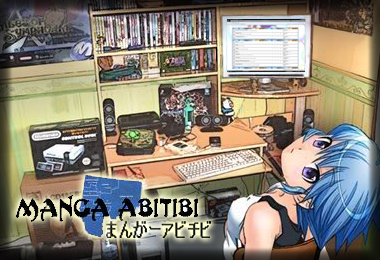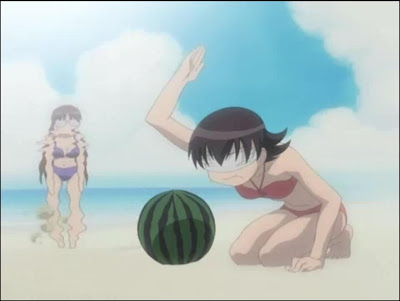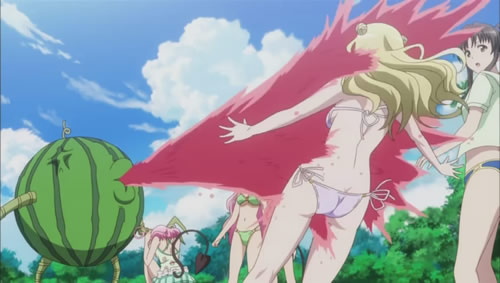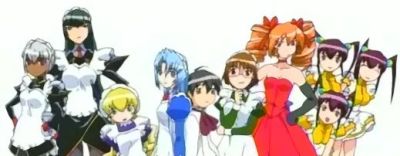Jeux que l'on vois dans les manga/animes
Page 1 sur 1
 Jeux que l'on vois dans les manga/animes
Jeux que l'on vois dans les manga/animes
Après un jolie petit message pm d'admin reçu il y a quelque temps me disant qu'elle était super contente d'avoir vue mon petit info sur le jeu du roi ''king's game'' dans les anime/manga.... et qu'elle était intéresser d'en voir plus.... j'ai décider de me creuser la tête pour trouver d'autre jeux fessant partie de la culture japonaise populaire que l'on vois généralement dans les anime et manga (on parle de jeu connu populaire et non pas isoler dans une ou deux série).
Alors en voici un autre que l'on retrouve très souvent dans un grand nombre d'anime et de manga a travers le temps.
じゃんけんぽん – jankenpon/janken
Des fois les partie de Jan ken pon peuvent être très imprévissible..... pas facile de gagner!!!
pas facile de gagner!!!
D'autre vidéo ici bas.
Alors en voici un autre que l'on retrouve très souvent dans un grand nombre d'anime et de manga a travers le temps.
じゃんけんぽん – jankenpon/janken
S’il y a bien une question que vous n’avez pas du vous poser, c’est sur l’histoire et l’origine de ce jeu auquel on a l’habitude de jouer pour se départager. il y a encore quelques temps j’y ai joué pour savoir qui allait commencer à distribuer le jeu (gang of four pour les curieux). Curieusement j’appelais toujours ce jeu chifoumi… mais pour la première fois je me trouvais confronté à quelqu’un qui l’appelait roshambo… une recherche devait nous départager. Le résultat de la recherche fut intéressant et me poussa à aller chercher plus loin.
Jan-ken-pon ( じゃんけんぽん), appelé parfois de façon plus courte janken (じゃんけん), souvent traduit d’autres manières telle que jankenpyon, janken-pon, etc., appelé parfois ishiken (いしけん, « pierre poing »), encore sous le nom de pierre-papier-ciseau en occident est un des jeux les plus populaires et le plus connu des jeux qui n’utilisent que les mains/poings, connu sous le nom de « jeu de ken (poing) » (拳遊び, ken asobi). Il a été inventé lors du 19e siècle et a acquis une popularité à travers le monde tout au long du 20e siècle.
Histoire
On pense que Janken est basé sur le plus vieux jeux de poing: san sukumi ken (三すくみ拳 ). San sukumi ken a existé au Japon de puis des temps anciens. Les historiens pensent que Janken a été inventé au 19e siècle à en juger par les sources papier de l’époque à propos des jeux de poing.
Que signifie ‘janken’?
Le Koujien (un dictionnaire japonais) définit ‘janken’ comme:
Une forme de main qui représente lorsqu’on ferme le poing: une pierre; lorsqu’on tend la paume: un papier; et lorsqu’on tend seulement les deux premiers doigts (index + majeur):les ciseaux. Les ciseaux battent le papier, le papier la pierre et la pierre les ciseaux et cela peut-être joué en compétition ou pour décider dans quel ordre des gens vont accomplir une action. Aussi appelé Ishiken (le poing de pierre)
Origine du mot janken ‘janken’
Une théorie est que ‘janken’ vient de ‘jakuken’ (kanji pour pierre et ken) ou de ‘ryanken’ (tuos les deux des kanji pour ken). Quoi qu’il en soit, cela peut venir aussi de l’expression Bouddhiste ‘ryakenhoui’, prononcé lorsque l’on fait une décision et que l’on recherche d’être guidé par Bouddha. ‘Pon’ peut simplement être un mot mimétique pour désigner l’indécision, ou il peut être dérivé d’un terme de mahjong. Il y a aussi la possibilité qu’il soit dérivé de laprononciation (d’un point de vu historique du mot chinois pour ‘habit’, qui est le troisième lancé dans le système chinois). Il semble clair que l’origine exacte du mot ne sera jamais vraiment connue.
Règles
Normalement, mais pas toujours, le jeu commence lorsque les deux joueurs chantent « Saisho wa gū! » (最初はぐう! , « On commence par la pierre! ») pendant qu’ils secouent leur poing dans un mouvement de pompe pour se synchroniser.
Ils répètent alors le même mouvement de pompe en chantant « Jan-ken-pon! ». Au mot « pon », les joueurs montrent un poing pour « pierre » ( ぐう, gû?), l’index et le majeur tendu formant un V pour les « ciseaux » (ちょき, choki), ou tous les doigts tendus pour « papier » (ぱあ, pâ). L’échange est gagné selon les régles suivantes:
1. Les ciseaux coupent le papier
2. Le papier recouvre la pierre
3. La pierre casse les ciseaux
Les égalités sont départagées en recommencant plusieurs fois jusqu’à ce qu’il y ait un vainqueur. Les joueurs recommencent leur geste de pompage en chantant « Aiko desho! » ( あいこでしょ! , « C’est une égalité! »). Ou alors avec le geste le plus rapide sur « pon! »or the more rapid single pump with « pon! ». IL existe beaucoup d’autres variantes régionales, bien que celle là est celle à laquelle j’ai été confronté avec des japonais venant de la région d’Akita (nord du Japon), de Tokyo, de Kyushu et Hokkaido.
Les signes des mains
pierre (ぐう, gû)
ciseaux ( ちょき, choki)
Papier ( ぱあ, pâ)
Variantes
Dans certaines versions du jeu, un second tour est utilisé. Après que l’un des joueurs ait gagné une manche de pierre/papier/ciseau, un autre compte de trois est conduit avec la phrase « acchi muite hoi » ( あっち向いてホイ, « Hé, regarde [tourne toi] par là »). A « Hoi », le joueur qui a gagné précédemment pointe vers l’une des quatre direction (haut, bas gauche droite) et les joueurs qui ont précédemment perdu penchent la tête dans l’une de ces direction. Si les deux directions sont les mêmes (celle pointée par le gagnant et celle pointé par un perdant), le jeu est fini et le joueur qui pontait la direction avec le doigt est déclaré gagnant, sinon le jeu retourne à un jankenpon de base et la victoire de la première manche est annulée.
Une autre variante utilise le rythme naturel des phrase et le compte jusqu’à trois; à chaque fois qu’une manche est jouée, le rythme du jeu est accéléré doucement. Tous les joueurs qui ratent le tempo perdent. C’est en fait très facile pour de longue séquence de manches, ou d’erreurs de deviner correctement au round d’après, pour finir le jeu qui atteinte des vitesses importantes.
En culture populaire
Janken est souvent utilisé comme moyen de duel dans les séries de jeu « Alex Kidd » créés par Sega, une série de jeux vidéos d’action sur Master System et Genesis.
De plus, dans le jeu sur NES « princesse Tomate dans le royaume Salade, deux des premiers jeux décris précédemment (jeux pierre-papier-ciseau et « ne regard pas par là ») sont utilisés chaque fois qu’un combat avec un ennemi arrive, avec la victoire souvent déclarée pour tous ceux qui gagnent la partie « ne regarde pas par là » 3 fois.
Janken fait aussi une brêve apparition dans le jeu de music/rythme sur Sony Playstation « PaRappa le rappeur » dans une scène ou trois des caractères (PaRappa, Katy Kat et P.J. Berri) sont entrain de se partager les corvées pour la fête d’anniversaire.
Dans le royaume musical, le groupe de Japan-Pop Mini Moni a fait un single appelé « Minimoni Jankenpon! ».
Au lieu des séquences tape-à-l’oeil standard, le dessin animé Bobobo-bo Bo-bobobo offre une partie de Janken avec les spectateurs (épisode dont la traduction anglaise est « Bo-bobo the fortune teller », Bo-bobo le medium/voyant)
Dans le manga Neon Genesis Evangelion, les caractères Misato Katsuragi et Shinji Ikari jouent au janken pour décider à qui sera le tour de faire à manger. Shinji perd la plupart du temps (malchance).
Dans la série dragonball, le caractère son-goku apprend à utiliser janken comme style de combat d’arts martiaux, apprentissage dispensé par son grand-père Son-Gohan.
Il utilisera ces techniques contre son maître Tortue-Génial déguisée (en Jacky Choun, dans la version française) lors du championnat du monde des arts martiaux.
On peut le voir aussi dans le jeu vidéo « dragonball », où l’attaque de Goku enfant utilise généralement janken.
Des fois les partie de Jan ken pon peuvent être très imprévissible.....
 pas facile de gagner!!!
pas facile de gagner!!!D'autre vidéo ici bas.
- Spoiler:
Habituel quand on joue....le but n'est pas d'imposer la pénalité au gagnant....luffy a pas compris le système
Des fois il y a de drôle de partie de janken.....errrrr... demandant beaucoup de compétitivité en sois.
Ne pas être stupid pour faire des partie de janken avec des adversaires qui ne peuvent que faire 1 choix.... et surtout ne pas s'humilier a perdre contre eux!!
la fameuse variante de faire regarder le perdant dans la direction que on pointe.... si la personne regarde pas du bon coté... ca ne compte pas.
Dernière édition par Neosilver le Mer 5 Déc 2012 - 0:40, édité 1 fois

Neosilver-

Nombre de messages : 2662
Age : 44
Ville : Rouyn-Noranda
Emploi/loisirs : TI Réseau
Mon Top 3 Anime/manga : il y en a trop et ca change tout le temps
Date d'inscription : 31/08/2012
 Re: Jeux que l'on vois dans les manga/animes
Re: Jeux que l'on vois dans les manga/animes
Je repos ici le jeux que j'avais mis dans le post original de la rencontre question de le regrouper avec les autres et qu'il sois ranger a sa place dans la bonne section du forum afin qu'il puisse être mieux consulter.
The King's Game is a popular party-dare game played using chopsticks.
Overview
The King's Game
The King's Game is known in Japan
as Ōsama Game (王様ゲーム), and it's a popular drinking game played by
university students. The themes of the game are similar to drawing lots
and Truth or Dare. A player will draw a pair of chopsticks that marks
them as the King and will issue an order for a random number to perform
some intimate or embarrassing act they command. After each order is
concluded, the chopsticks are gathered and re-drawn to selects a new
King.
The act of the numbers being
anonymous makes it so the King must be cautious about what order they
give since they don't know what the ultimate outcome could be. Since the
game is often played by adults who are drinking. The orders may tend to
become more outlandish as the game goes on.
King's Game Rules
The Kings Game needs chopsticks
The
first step in playing King's Game is to gather a pair of chopsticks
equal to the number of players, but some versions of the game have been
shown using slips of paper in a basket. One pair is either marked by
writing the first kanji for king (王, Ou) at the joint or painted red.
The following pairs are numbered from 2 and so on. These are then held
in the hand of one player or in a tall cup with the markings concealed.
Each player draws one pair of chopsticks but must hide their number by
holding it to their chest. Only the player who draws the King set is
revealed after everyone has made their selection.
The
player who holds the King set will then issue any command they wish by
calling out the number. For example, No. 2 must kiss No. 5. The King can
also command a number to perform an action to them. The King's order is
considered absolute. Once the round is over, all the chopsticks are
gathered, shuffled, and redrawn.
No matter the command, the King's commands are "Absolute!!".
Appearances in Manga/Anime
The King's Game has made several brief appearances in a series of manga and anime series throughout the years.
Gintama (2007)
In Gintama - Episode 83,
the assorted cast members are moonlighting as hostesses in a snack bar
when the Shogun himself, Shige Shige Tokugawa, decides to visit. After a
series of gags at trying to welcome the Shogun, they end up trying to
play the King's Game (Shogun's Game) in this episode. Each turn the
number 1 position rotates to the various characters, but the person
being humiliated ends up being the real Shogun until Shige Shige is
naked and is ordered to walk outside to buy some underpants (while still
naked). Despite this, the Shogun tells Kyubei at the end of the episode
that he enjoyed the game and thought it was a fun change of pace. It
marked the start of a small running gag where every time the Shogun
appeared in Gintama, the episode would somehow end with him becoming
naked.
Okamisan (2010)
Okami-san, Ep. 8 - Ringo kisses Ryoko
In Okamisan - Episode 8,
the King's Game was shown being played in the finale after the main
story. This was part of a movie parody scene that began in the opening
of the episode. In the scene, the Bunta brothers challenge Ryoko, Ryoshi, and Ringo
to the King's Game. One of the brother's is the King at the start and
orders two numbers to kiss. This turns out of be Ryoko and Ringo. Though
Ringo kisses Ryoko without protest, she warns the brothers of what's to
come when she gets the King piece.
Baka and Test -- Summon the Beast (2010)
Baka and Test - Summon the Beast DVD Vol. 5 - The gang play the King's Game
During a video extra included in the fifth DVD volume of Baka and Test -- Summon the Beast, the King's Game is played among the cast but using slips of paper in place of chopsticks. Yuuji Sakamoto is the first King, and Akihisa Yoshii and Kouta Tsuchiya try to avoid his embarrassing command. The second King to be drawn is Aiko Kudou. She orders number two and four to kiss. Mizuki Himeji drew the No. 2 piece and hoped she would get to perform this with Akihisa Yoshii, but No. 4 was revealed to be Minami Shimada. The third King to the horror of most is Shouko Kirishima. Her command gets Yuuji Sakamoto tied in bondage style. The final King shown in this extra is Akihisa Yoshii.
Ōsama Game (2011)
Osama Game Vol. 1 JPN (Jan 2011)
Ōsama Game
is a horror manga series where a the King's Game was used as a theme in
a cell phone game that leads to the death of several students being
sent text messages by an unknown King issuing orders to them. At
midnight, a text message is sent issuing orders as well as the
punishment for not completing the command within twenty-four hours. Each
day at midnight, new and more escalating orders are sent through email.
Persona 4 The Animation (2011)
Persona 4 The Animation, Ep. 15 - Yu Narukami's the King
In Persona 4 The Animation - Episode 15, the King's Game appeared as the members of the Investigation Team were on their free day from the school trip. Rise Kujikawa initiates the game after believing that many of their members are drunk at a club. Teddie
is the first to be the King and commands one of the members to kiss
him. He tries to change his mind to another number wen it's revealed to
be a guy, Kanji Tatsumi. Yu Narukami is the next King. He orders No. 2 to sit on his lap, and that turns out to be Chie Satonaka. Next, Yukiko Amagi
sits on his lap, hugging him; and Rise then rests her head on his lap.
In Episode 19, Yu tries to bring back the King's Game during the school
festival, but Chie shoots him down.
Is This a Zombie?...Of the Dead (2012)
Is This a Zombie? Of the Dead Ep. 8 - Playing the King's Game
In Is This a Zombie ...Of the Dead - Episode 8, the King's Game is played among a group date party. Rather than chopsticks, paper strips were used for the pieces. Eucliwood Hellsythe is the first king and commands No. 2 and No. 5 to hug. The reluctant Ayumu Aikawa and Taeko Hiramatsu
then embrace. The second king is one the the restaurant staff workers
who was pulled into the party. He commands No. 3 and No. 7 to share a
passionate kiss. No. 3 is revealed to be Kyoko and Aymumu is No. 7. However, their kiss is interrupted by the late arrival of Ariel. The party then turns to karaoke.
In
the omake after the credits, the various chibi Yu characters play the
King's Game among themselves. The first king orders B and C to kiss,
then the real Eucliwood appears to join in, but a king for that round is
never revealed.
Dernière édition par Neosilver le Sam 26 Jan 2013 - 2:49, édité 1 fois

Neosilver-

Nombre de messages : 2662
Age : 44
Ville : Rouyn-Noranda
Emploi/loisirs : TI Réseau
Mon Top 3 Anime/manga : il y en a trop et ca change tout le temps
Date d'inscription : 31/08/2012
 Re: Jeux que l'on vois dans les manga/animes
Re: Jeux que l'on vois dans les manga/animes
Un autre ''jeux'' que l'on vois très très souvent dans des tonnes de manga/anime est le fameux Kimodameshi..... sérieux je pense que c'est LE jeux le plus répendue dans tout les série school life like.... Aussi connu en anglais sous le nom ''Test of Courage'' c'est un jeux qui est une version japonaise de nos fameuse maison hanté ici en amérique..... sauf que cela se fais a plusieurs personnes et généralement un peu plus organiser comme event....
Bien que la plus part du temps se genre d'activité se fais lorsque le monde sont en excursion dans des lieux a la campagne, loins de la ville et du récomfort des structure..... les kimodameshi peuvent se faire dans n'importe qu'elle lieux sombre, silentieux et non rassurant.... cela peut être autant a l'intérieur d'une école ou d'un manoir... des ruine abandonner ou juste le bon vieux sentier d'une forest.... le but est de partir du point A et se rendre au point B avec son partenaire.... et de garder ses sous vêtement propre!! Bien souvent rendu au point B se trouve un altar ou on dois ramasser ou déposser un truc pour prouver que le test est accomplie.
bon c'est vraiment pas le meilleur anime pour donner un exemple surtout si vous ne connaissez pas cette série vous aller peut-être perdre votre cerveau a écouter ceci... et être plus déconcentrer par le contexte de la série plutot que d'apprendre sur le kimodameshi... mais tout est bon!!! enjoy!!
surtout si vous ne connaissez pas cette série vous aller peut-être perdre votre cerveau a écouter ceci... et être plus déconcentrer par le contexte de la série plutot que d'apprendre sur le kimodameshi... mais tout est bon!!! enjoy!!
Kimodameshi, usually translated as "test of courage," is a game similar to going to an amusement park Haunted House. Pairs of teenagers (frequently couples, but sometimes it's Not a Date) negotiate a course at night that's set up to be as scary as possible; the path usually leads past carefully-designed eerie scenes, out of which an actor in a ghost costume will occasionally leap to increase the shock factor. It basically identical to PG-rated American-style haunted houses - and, like haunted houses worldwide, it's a chance to give teenagers an excuse to cling to each other.
Kimodameshi is primarily a Japanese cultural artifact; it differs from a Western Scare Dare game in that the kimodameshi is more organized, and works like an ad hoc adolescent Rite of Passage.
It's also an excellent excuse for the writers to spotlight a Love Dodecahedron or push along a Slap-Slap-Kiss relationship. Teams are sometimes randomly assigned, which gives plenty of chances for characters to regret being paired with the "wrong" partner....
Examples:
- One of the late stories of Ranma 1/2 sends the cast, paired off, into a "Cave of Lost Love" that really is haunted as part of a plot by Ukyo Kuonji (plus Shampoo in the OVA) to break up Ranma and Akane. The plan backfires quite spectacularly on Ukyo and Ryoga Hibiki, and may even have been intended as Ship Sinking by the author: comparing Ukyo and Ryoga's selfish alliance of convenience (which has only just escaped breaking apart due to Ryoga's own difficulty with controlling his emotions) to Ranma and Akane's bickering and angry banter, the ghosts conclude that Ranma and Akane hate each other, while Ryoga and Ukyo are one of the happy couples they seek to break up. They promptly start ignoring Ranma and Akane to try and break up Ryoga and Ukyo, ignoring their protests that they aren't the couple here. The backstory to the Cave of Lost Love heavily implies that, after this experience, they will never be able to become a couple- this is all but made explicit in the manga version, which ends with a scene of Ryoga and Ukyo fighting bitterly over whose fault this was.
- Possible related to this trope is the "zombie-demon show" that Mousse takes his date to at the end of one late manga story. Unfortunately for him, as his date is Shampoo, she does not find it romantic or frightening in the slightest and is instead angrily disgusted, beating Mousse up and leaving him there for his troubles.
Family Compo with Masahiko and Shion at a festival on a Not a Date, supposedly testing whether participants are a "real couple". They pass, of course. Hana Yori Dango Kashimashi: Girl Meets Girl Marmalade Boy Sailor Moon Cardcaptor Sakura used this theme as a vehicle for one of the Cards in the first season.
This also worked very well with Sakura's fear of ghosts in a few episodes. One episode of Keroro Gunsou had Momoka suggest the group do this, as part of her latest scheme to get closer to Fuyuki.
Same in the manga, where things are complicated by running into a real ghost, one of a Japanese fighter pilot from World War II who briefly bonds with the frogs. In the English version of the manga, "Kimodameshi" was translated to "Playing Chicken." Love Hina sends its chaotic cast through a "haunted house" as part of its Festival Episode, with semipredictable results. Great Teacher Onizuka did this during the Okinawa class trip (and had plenty of Japanese horror movie references sprinkled throughout).
Not only, it also referenced The Thing 1982, with a head-spider that had Onizuka's facial features! Ouran High School Host Club held a kimodameshi tournament for Halloween, the prize going to the builders of the scariest haunted house. Similarly to the Ouran High School Host Club entry just above, class 3-A of Mahou Sensei Negima! builds a haunted house (complete with an actual ghost) for the gigantic, no-holds-barred festival that is Mahorafest. Given that most of the class adores Negi, there's a lot of fighting over who gets to escort him through it. Dennou Coil also featured a kimodameshi competition, made more interesting by the use of digital horrors. It's nice to note that, among the usual monsters, the digital creatures also included The Greys, Chupacabras and the Flatwoods monster .
Also, the ability to shoot back.. Bludgeoning Angel Dokuro-chan spoofed this, with the main character commenting that he expects cat robots from the future, nurse-witches, reindeer who are doctors, or moving castles to pop out... Code Geass has this in the school festival episode of Season 1; Kallen plays a tombstone/Nurikabe hybrid, and ends up scaring Ougi and Viletta who pass by on a date. Megaman Battle Network 4 has a Boktai-based one in the amusement park. Variety shows on Japanese TV have gotten a lot of mileage out of sending their hosts or other well-known talents through supposedly haunted buildings. Natsume Yuujinchou featured one of these, complete with creepy house with a haunted reputation... it soon starts going downhill... Kamen Rider Den-O includes one that's laughably un-scary to any rational viewer and most of the characters, but frightens Deneb so badly that it causes Yuuto to waste one of his two remaining single-use transformation trinkets.
Also had a little chihuahua statue that scared the hell out of Momotaros for some reason. Kakeru in Psycho Busters encounters one of these who manage to come across his psychic friends and mistake them for ghostly activity: hitodama created by Kaito, Ayano's astral form, and Xiao Long who closely resembles a Zashiki-warashi. In School Days, the cultural festival haunted house was basically a front for a private room where couples could have sex. Unknown to most of the student body, the activities there were videotaped for the later entertainment of the senior class. In Strawberry Panic, Tamao uses one of these as an opportunity to frighten Nagisa so that she can record her screams. Simultaneously disturbing and hilarious... Spoofed in an episode of Full Metal Panic? Fumoffu. Sousuke and Kaname visit an Abandoned Hospital at night, and Kaname hopes it will scare The Stoic Sousuke. Given that he's been a mercenary since he was eight, intangible things like ghosts and strange voices don't frighten him a bit, and Kaname divides her time between being afraid, and getting annoyed at Sousuke for not being afraid. The only thing that scares him in that episode is Kaname's apparent death, and he admits as much as the two of them ride home together on his bike. A Fruits Basket example: Despite being terrified of haunted houses, Tohru agrees to accompany Momiji, Kyo, Yuki, and Hatsuharu through one at the beginning of summer break. She becomes so frightened she starts to cry, at which point both Kyo and Yuki offer to lead her through. Embarrassed, they begin to fight, only for Momiji to take Tohru's hand and scold them for letting their rivalry come between helping a girl in need. To Love-Ru had one of these early on, with the addition of a rumor stating that the pair that makes it to the end will become an actual couple. Naturally, Rito makes it to the end with both Haruna and Lala with him. In Dept Heaven Apocrypha, Meria asks Monica (actually looking for her Plot Coupon) if she's on a solo test of courage. Damekko Doubutsu also did this. Kimi ni Todoke has one of these near the beginning. If it had not been for one of these, the plot of Psychic Detective Yakumo would probably not have either Haruka or Yakumo in it. Karin's class creates one for the Festival Episode, with Usui's creepy eye providing scares. That works a little too well; several crying kids have to be escorted out. Ai Kora has a chapter where our perverted hero sets up his classroom's haunted house at the school festival so as to be able to sneak around and take pictures of girls with his "beloved parts" in Rambo-inspired gear. When he sees two other guys trying to hit on the girls, he terrifies them into oblivion by striking from the shadows. Suzumiya Haruhi features one in Endless Eight. Invoked by name in the eighth Touhou game, Imperishable Night: The Extra Stage is set up as Kaguya inviting each of the playable teams to one of these. Happens in episode 3.1 of Shinryaku! Ika Musume, mostly as an effort by Eiko to scare Ika-chan, who wasn't raised in human society and has no idea why the whole ordeal was supposed to be scary. After getting separated from the group, Squid Girl then accidentally freaks out the human characters when she activates her glow-in-the-dark mode and chases after them, wondering why they keep running from her. When actual ghosts appear around her and escort her back to safety, she never realizes what they are, instead musing that not all humans are bad. K-On: Sawako-chan makes an appearance as the final scare, much to Ritsu's disgust when no one makes it to her trap. Seen in a two-part story arc in Kirby of the Stars, complete with a haunted house sent by Nightmare. Baka To Test To Shoukanjuu uses this as a competition between the 2nd year students and 3rd year students. This takes place in a Matrix-like environment with the summoned creatures all re-themed as Japanese horror monsters. Whoever screams, loses. Da Capo II features an event based on The Seven Mysteries of the school. Tokyo Mew Mew: Ichigo Momomiya and Masaya Aoyama go to one of these at an amusement park in one episode. Poor Ichigo ended up fainting, but that's okay, because Masaya carried her through it! Happens in several routes of Aoi Shiro. Yasumi and Nami's routes have them accompany the protagonist (and would be love-interest) Syouko. It also occurs in Kohaku's route but this time Syouko is accompanied by Ayashiro who is just a friend (much to the disappointment of Yasumi and Nami both).
Bien que la plus part du temps se genre d'activité se fais lorsque le monde sont en excursion dans des lieux a la campagne, loins de la ville et du récomfort des structure..... les kimodameshi peuvent se faire dans n'importe qu'elle lieux sombre, silentieux et non rassurant.... cela peut être autant a l'intérieur d'une école ou d'un manoir... des ruine abandonner ou juste le bon vieux sentier d'une forest.... le but est de partir du point A et se rendre au point B avec son partenaire.... et de garder ses sous vêtement propre!! Bien souvent rendu au point B se trouve un altar ou on dois ramasser ou déposser un truc pour prouver que le test est accomplie.
bon c'est vraiment pas le meilleur anime pour donner un exemple
 surtout si vous ne connaissez pas cette série vous aller peut-être perdre votre cerveau a écouter ceci... et être plus déconcentrer par le contexte de la série plutot que d'apprendre sur le kimodameshi... mais tout est bon!!! enjoy!!
surtout si vous ne connaissez pas cette série vous aller peut-être perdre votre cerveau a écouter ceci... et être plus déconcentrer par le contexte de la série plutot que d'apprendre sur le kimodameshi... mais tout est bon!!! enjoy!!
Neosilver-

Nombre de messages : 2662
Age : 44
Ville : Rouyn-Noranda
Emploi/loisirs : TI Réseau
Mon Top 3 Anime/manga : il y en a trop et ca change tout le temps
Date d'inscription : 31/08/2012
 Re: Jeux que l'on vois dans les manga/animes
Re: Jeux que l'on vois dans les manga/animes
Pas facile de se creuser la mémoire pour se rappeler de jeux de folklore et culturel du japon que on vois dans les animes/manga...... Ce jeux la j'ai toujours eu de la difficulté a bien comprendre son concept..... mais bref.... c'est comme un genre de mélange de jeux d'appeler des esprits et des fameuse histoire que les jeunes se raconte dans les camps de vacance la nuit autour du feux de camps..... genre on s'amuse a se raconter des histoires a faire peur....
le jeux se nomme Hyakumonogatari Kaidankai (A gathering of one hundred supernatural tale) et cela se joue par contre a l'intérieur d'un batiment ou il dois y avoir 3 salle.... le monde se tienne dans la 1er salle et le conteur dois se rendre dans la 3e salle après son histoire... je suppose que la 2e salle qui n'est pas mentionner sert en réalité de salle de transition pour créé de la tension et de la distance pour l'atmosphère...


c'est le genre de jeux j'ai l'impression qui dure une bonne parti de la nuit.... et le tout est d'avoir de très bon compteur. Surement qu'il existe plein de variante que le monde peuvent adapter selon le lieu.
des version moderne du jeux sont jouer genre a 4 bougie (on on peut utiliser quand même les fameuse 100 bougie) au 4 coins d'une seule salle... 4 ayant une signification superstition comparable a notre chiffre 13 ici en amérique. (nous on a pas de 13 étage dans les batiment.... eux au japon ils ont pas d'autobus #4 ou il y a pas de chambre d'hopitale #4... le hiragana est modifier pour un autre symbole a la pronomciation similaire comme kotobuki)
le jeux se nomme Hyakumonogatari Kaidankai (A gathering of one hundred supernatural tale) et cela se joue par contre a l'intérieur d'un batiment ou il dois y avoir 3 salle.... le monde se tienne dans la 1er salle et le conteur dois se rendre dans la 3e salle après son histoire... je suppose que la 2e salle qui n'est pas mentionner sert en réalité de salle de transition pour créé de la tension et de la distance pour l'atmosphère...

The game was played as night fell upon the region using three separate rooms. In preparation, participants would light 100 andon in the third room and position a single mirror on the surface of a small table. When the sky was at its darkest, guests gathered in the first of the three rooms, taking turns orating tales of ghoulish encounters and reciting folkloric tales passed on by villagers who claimed to have experienced supernatural encounters. These tales soon became known as kaidan. Upon the end of each kaidan, the story-teller would enter the third room and extinguished one andon, look in the mirror and make their way back to the first room. With each passing tale, the room slowly grew darker and darker as the participants reached the one hundredth tale, creating a safe haven for the evocation of spirits.
However, as the game reached the ninety-ninth tale, many participants would stop, fearful of invoking the spirits they had been summoning.
The game of Hyakumonogatari Kaidankai became a cult phenomenon in Japan, and while the hype of these tales has receded, many J-horror films and Japanese urban legends can be attributed to the parlour game's influence. Woodblock painter and founder of the Maruyama-Shijo School of Painting, Maruyama Okyo is considered the first artist to offer paintings of the yurei who were frequently cast in kaidan.[2]
In 2002, Fuji TV released the television program "Kaidan Hyakumonogatari" using the basis of the game Hyakumonogatari Kaidankai to tell classic Japanese ghost stories. The series starred Naoto Takenaka and showcased 11 episodes, including an episode which focused on the tale of Yuki Onna.
The popularity of Hyakumonogatari Kaidankai is not limited to Japan, in the Episode "Freshman Fear" of the A&E docu-drama reality television series Paranormal State, members of Penn State Paranormal Research Society play the Ancient Japanese Game of One Hundred Candles during their investigation of a supposed haunting in a student dormitory.
Other cultural influences include:
- In the tenth episode of the anime xxxHolic Yūko invites Watanuki, Doumeki and Himawari to the Hyakumonogatari Kaidankai.
- In Season 2, Ep. 13 of the anime School Rumble, the students of 2-C can be seen playing the game throughout the episode.
- An adaptation opens the anime series Ghost Hunt.
- In the manga Sundome the members of the Roman Club play Hyakumonogatari Kaidankai in one scene.
- One of the Conversation Skills in Persona 2: Eternal Punishment is the '100 Stories', with a special reward for when players manage to display all 100 scripted stories.
- A 1968 film starring Miwa Takada
- In the fifth episode of the anime Sengoku Otome: Momoiro Paradox, the main characters are forced to participate in this by a group of undead samurai warriors.

c'est le genre de jeux j'ai l'impression qui dure une bonne parti de la nuit.... et le tout est d'avoir de très bon compteur. Surement qu'il existe plein de variante que le monde peuvent adapter selon le lieu.
des version moderne du jeux sont jouer genre a 4 bougie (on on peut utiliser quand même les fameuse 100 bougie) au 4 coins d'une seule salle... 4 ayant une signification superstition comparable a notre chiffre 13 ici en amérique. (nous on a pas de 13 étage dans les batiment.... eux au japon ils ont pas d'autobus #4 ou il y a pas de chambre d'hopitale #4... le hiragana est modifier pour un autre symbole a la pronomciation similaire comme kotobuki)

Neosilver-

Nombre de messages : 2662
Age : 44
Ville : Rouyn-Noranda
Emploi/loisirs : TI Réseau
Mon Top 3 Anime/manga : il y en a trop et ca change tout le temps
Date d'inscription : 31/08/2012
 Re: Jeux que l'on vois dans les manga/animes
Re: Jeux que l'on vois dans les manga/animes
Fesait un bon bout de temps que je voulais ajouter ce post a ce sujet. Surement il y en avais qui l'attendais. Un jeu populaire que l'on vois dans tout les animes et les manga qui on une épisode ou un chapitre a thématique de plage ou d'été.
Le suikawari, appeler en anglais Watermelon Cracking, est un jeu traditionnel du japon depuis de très longue année. Bien que de nos jour, il est surement moins populaire a cause de l'économie (qui fait qu'un *?*&%& de melon d'eau coute 2 bras a acheter) et de l'écologie environnemental des plages qui ne sont plus aussi... ''saine'' que jadis a la belle époque.
Voici le principle du jeu
Un bokken en passant est ce fameux sabre en bois que l'on vois souvent des personnages utiliser tout le temps pour donner une racler (étrangement souvent utiliser par les tsundere pour taper sur les gars... )
)
Contrairement a parfois ce qu'on peut voir dans les anime ou manga... le melon d'eau est toujours placer sur une grande toile.... a moins que vous aimer avoir du sable dans votre pastèque.....
Il peut y avoir des tas de variante a ce jeu.... tant que le principle reste le même.
en exemple, il arrive que le fameux gars malchanceux (celui que les filles aime torturer ou faire souffrir) se retrouve enterrer jusqu'au coup a coté du melon d'eau et que ceux qui crie pour guider la personne essaie plutot de t'envoyé sur lui plutot que sur le fruit.
souvent celui qui est désigner pour couper le melon d'eau (pas tout le temps un principle de tour de role) est un ace épéiste ou un héritié d'un dojo qui coupera la pasteque parfaitement (l'écraser est moins le fun pour le manger par la suite)
parfois le melon d'eau est juste détruit par une autre manière inatendu. Le but reste d'avoir du fun.
Sinon si vous penser que ce n'étais pas une coutume traditionnel important au japon... il existe un petit gadjet que vous pouvez vous procurer pour une modique somme de 250$ taxe incluse. ouais quoi de mieux que de pouvoir vous promener a la plage avec votre melon d'eau... bien au frais!! et oui.. un cooler portable que vous pouvez utiliser pour garder votre fruit frais par ces temps de chaleur. L'appareil peut servire de heater aussi pour vos steam buns ou votre café bien chaud. Il est possible de brancher l'appareil dans une prise mural ou dans les allume cigares des autos.

Le suikawari, appeler en anglais Watermelon Cracking, est un jeu traditionnel du japon depuis de très longue année. Bien que de nos jour, il est surement moins populaire a cause de l'économie (qui fait qu'un *?*&%& de melon d'eau coute 2 bras a acheter) et de l'écologie environnemental des plages qui ne sont plus aussi... ''saine'' que jadis a la belle époque.
Voici le principle du jeu
A very popular party game played in Japan mostly during summer and outside, especially at beaches - a trip to the beach is not complete without a round of suikawari.The word translates quite literally as watermelon splitting ("suika" means watermelon, "wari" is a nominalized form of the verb waru, "to split").
And this is how you play it:
- The watermelon is placed on the ground
- Each player in turn is blindfolded and given a stick (often a bokken)
- He or she is disoriented by spinning.
- The player then tries to find and split the watermelon, helped (or hindered) by shouted hints from the others
- Everyone gets only a single whack at a time
- When someone finally manages to split open the melon, everyone gets a share
Un bokken en passant est ce fameux sabre en bois que l'on vois souvent des personnages utiliser tout le temps pour donner une racler (étrangement souvent utiliser par les tsundere pour taper sur les gars...
 )
)Contrairement a parfois ce qu'on peut voir dans les anime ou manga... le melon d'eau est toujours placer sur une grande toile.... a moins que vous aimer avoir du sable dans votre pastèque.....
Il peut y avoir des tas de variante a ce jeu.... tant que le principle reste le même.
en exemple, il arrive que le fameux gars malchanceux (celui que les filles aime torturer ou faire souffrir) se retrouve enterrer jusqu'au coup a coté du melon d'eau et que ceux qui crie pour guider la personne essaie plutot de t'envoyé sur lui plutot que sur le fruit.
souvent celui qui est désigner pour couper le melon d'eau (pas tout le temps un principle de tour de role) est un ace épéiste ou un héritié d'un dojo qui coupera la pasteque parfaitement (l'écraser est moins le fun pour le manger par la suite)
parfois le melon d'eau est juste détruit par une autre manière inatendu. Le but reste d'avoir du fun.
Azumanga Daioh: In the first Beach Episode, they don't have a stick and Tomo tries to split it with a karate chop. She never manages to hit it. The second time around, Tomo ignores that they have a bat, and Kagura takes the bat and splits the watermelon before Tomo can put everyone through the karate chop debacle again. Tomo whines about it for a bit afterwards, and Kagura tells her to grow up. In the manga's third one, they don't have a watermelon, and Tomo hunts desperately for something to smash.
Fruits Basket: Done at the beach, and Tohru talks about how she used to do it with her mom.
- And then when they actually try it, martial artist Haru smashes one with his bare hands, so Tohru decides to try it that way as well...
Full Metal Panic? Fumoffu: Sousuke's classmates try to set this up for him. He marches off some distance away, discards the wooden stick, and blows the watermelon away with a shotgun, hitting it dead on but Comically Missing the Point. As in, he not only complains that it's too simple, he also sprays Kaname with watermelon juice even though she chose her swimsuit specifically to show off to him. She's not amused.
- In the first FMP series Handsome Lech Kurz Weber starts hitting on Kaname at the beach whereupon Melissa Mao forcibly plants a watermelon on top of his head. Then Kyoko comes up and hits it with a stick.
Lucky Star: Konata mentions that only rich people would want to spend the money to do this, but rich people aren't usually the sort who would do it anyway. Sure enough, rich girl Miyuki's never done it. Konata also directly refers to the Fumoffu example above.
Mahoraba: Tamami ignores the shouted directions, walks right to the watermelon, and slices it neatly (using a wooden bokken) into quarters.Nogizaka Haruka No Himitsu: While Yuuto and Haruka try to teach Shiina to swim at the school pool, the side characters suddenly turn up for no reason and act like they're at the beach. A watermelon is produced, Ninja Maid Hazuki is blindfolded and given a baseball bat, and she promptly breaks the bat trying to hit Yuuto.
- Later, a straight version of the trope is used during the actual Beach Episode.
Done several times in Ranma ½.
- Ranma was once forced to participate in a Martial Arts Watermelon Splitting contest, in which the participants must race to the finish line with their watermelon intact to win, while trying to break each others watermelons with a bokken.
- Tatewaki Kuno once turned this game into Training from Hell. He stood under a waterfall on the originally named Watermelon Island, and smashed every watermelon that fell off the waterfall towards him. A watermelon to the head gave him Easy Amnesia, but the training worked - whenever he saw a watermelon, his speed and strength would increase tenfold, allowing him to easily defeat his rival Ranma, who was unfortunately wearing a watermelon-print bathing suit. His new watermelon-slicing skills also made him a hit with ladies. Of course, Status Quo Is God, so when Kuno's memory returned at the end of the story arc, his newfound skill disappeared.
- Actually, that's not true- he retained the skill, it's just that his training is subliminal conditioning to destroy watermelons. It's absolutely useless unless his opponent is holding or otherwise resembling a watermelon, something that Ranma is well aware of. In fact, Kuno himself knows that the Watermelon Island training is useless for combat- he never intended for it to be any use in combat (being so egotistic that he already considers himself unbeatable): he wanted to upgrade his talents at slicing watermelons in order to impress girls, particularly Ranma's girl-form.
In Urusei Yatsura there was actually a story where Lum, Ataru, Mendo and Shinobu tried to acquire a watermelon to play the game, only the town they were in refused to sell them due to their fear of the wrath of the local Watermelon God. The group wind up pissing off the Melon God anyway, and it turned out that it's terrible wrath was spitting watermelon seeds at the people who angered it.
Subverted in School Rumble because Mikoto almost drowned.Done in Tengen Toppa Gurren Lagann, to show how utterly great Princess Classic Nia is at everything.
- Also played with somewhat: the dark stripes on the melon are actually an octopus-like creature's tentacles and it tries to dodge out of the way.
The To Love-Ru manga has the watermelon turning into a Naughty Tentacles monster. This is about par for the course.
Hidamari Sketch: No Beach Episode in this series. However, Yuno finds an inflatable watermelon-like beachball in the shed and plays around with it in this manner, "just to get the feeling."
In the Beach Episode of Bleach (episode 228), everyone fights a Naughty Tentacles monster, but it turns out that the monster is made of watermelon, and was part of a surprise watermelon smashing game.
In Sayonara, Zetsubou-Sensei the watermelon says "Don't open it!"
Hanaukyo Maid Tai episode 9. Taro and the maids forget to play this during their Beach Episode, so they do it while most of the mansion's maids have gone home on vacation. Security chief Konoe does a #3 multiple times.
Done in the Beach Episode of Hoshizora e Kakaru Hashi. Ibuki repeatedly tries to smack Kazuma with the stick (leading him to accuse her of being able to see in spite of the blindfold), while Ui sniffs out the watermelon and hits it without needing guidance.
Sinon si vous penser que ce n'étais pas une coutume traditionnel important au japon... il existe un petit gadjet que vous pouvez vous procurer pour une modique somme de 250$ taxe incluse. ouais quoi de mieux que de pouvoir vous promener a la plage avec votre melon d'eau... bien au frais!! et oui.. un cooler portable que vous pouvez utiliser pour garder votre fruit frais par ces temps de chaleur. L'appareil peut servire de heater aussi pour vos steam buns ou votre café bien chaud. Il est possible de brancher l'appareil dans une prise mural ou dans les allume cigares des autos.


Neosilver-

Nombre de messages : 2662
Age : 44
Ville : Rouyn-Noranda
Emploi/loisirs : TI Réseau
Mon Top 3 Anime/manga : il y en a trop et ca change tout le temps
Date d'inscription : 31/08/2012
 Re: Jeux que l'on vois dans les manga/animes
Re: Jeux que l'on vois dans les manga/animes
UPDATE : post Suikawari -- j'y ai mis les images.. c'est tellement long faire la recherche que je post le texte en premier ensuite j'ajoute les images.

Neosilver-

Nombre de messages : 2662
Age : 44
Ville : Rouyn-Noranda
Emploi/loisirs : TI Réseau
Mon Top 3 Anime/manga : il y en a trop et ca change tout le temps
Date d'inscription : 31/08/2012
Page 1 sur 1
Permission de ce forum:
Vous ne pouvez pas répondre aux sujets dans ce forum



























